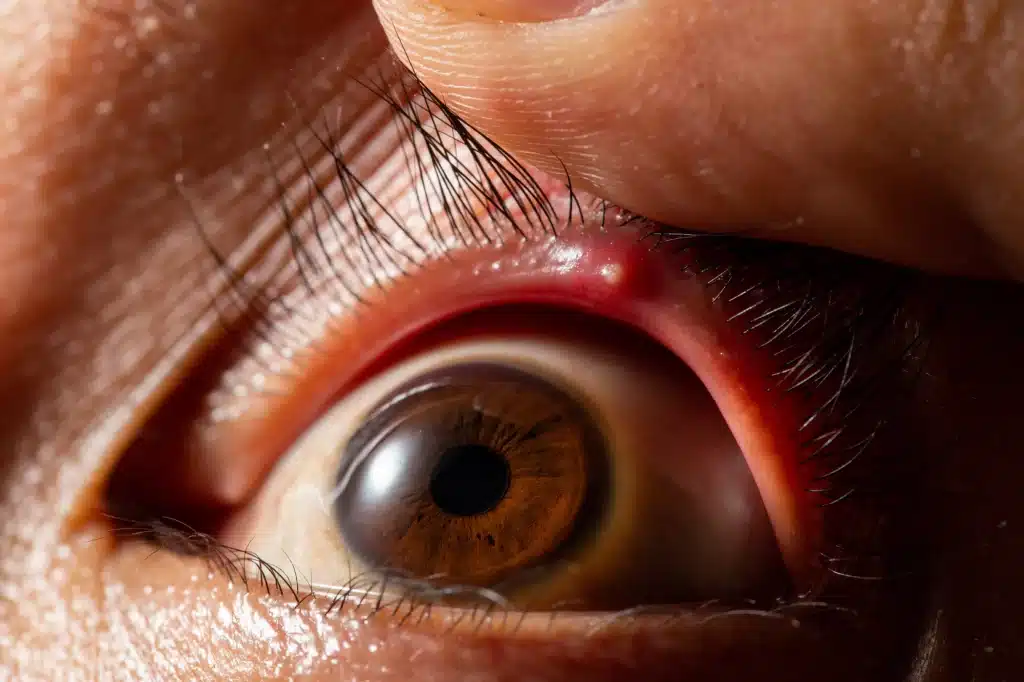Medically Reviewed by: Edward C. Wade, M.D., F.A.C.S.
What Are Computer Glasses and Do I Need Them?
How to reduce eye strain when working with computers
Screens are an everyday part of our lives. But unfortunately, this has made computer vision syndrome (CVS) more commonplace. Luckily, however, computer glasses can help people struggling with CVS symptoms to use their devices without eye strain.
However, there’s a lot of confusion and misinformation surrounding eye strain, and consumers are purchasing “computer glasses” that don’t actually provide the relief they’re looking for.
If you’re considering getting glasses to protect your eyes from your computer screen, take a moment to read the below article and to make sure you know the true answer to the question, “What are computer glasses?”
What causes eye strain when using a computer?
When our patients ask us, “What are computer glasses?” we’ve noticed a hidden assumption behind this question. More specifically, they believe computer glasses are designed for blocking blue light. While this idea isn’t exactly untrue, it’s not right on the money, either.
What is blue light?
Blue light (light rays with short wavelengths) is a natural part of our environment. In fact, blue light has been shown to help regulate our sleep cycle. When the sun rises and emits blue light, it sends a signal to our eyes that it’s time to get up. Once the sun goes down and the amount of blue light diminishes, our body knows to secrete melatonin (a hormone that helps us sleep).
So, is blue light bad for our eyes? Does it cause issues like UV light eye damage? More to the point: Does looking at a screen damage your eyes?
Computer screens emit blue light, and overexposure to blue light around bedtime can inhibit your ability to fall asleep and contribute to eye strain. However, there is still some debate as to whether or not blue light increases your likelihood of cataracts or glaucoma.
Eye strain causes
Blue light is one of many eye strain causes. Your eyes can also get tired from the glare of bright lights, especially if your screen doesn’t contrast with the lighting in your room. However, a significant amount of patients deal with eye strain because of focusing issues.
In particular, people tend not to blink enough when they’re focusing on their computers, which can lead to dry eyes. Individuals who already wear glasses likely struggle with an additional issue: their glasses may not be designed to focus on intermediate distances.
Typically, a computer screen stands 20 – 25 inches away from a person’s eyes, which is farther away than most people hold books or other reading material. Patients who wear glasses (bifocals especially) that weren’t made for computer work often have to tilt their head to see the computer screen well. Tilting your head this way can cause eye strain, as well as neck, shoulder, back, and arm pain.
Individuals over the age of 40 may also struggle with computer-related eye strain due to presbyopia (also called “near vision”), a condition caused by a loss of elasticity in your eye’s lenses. Near vision treatment is available for this, and it can help alleviate some of these symptoms.
What are computer glasses? (And do computer glasses work?)
Now that we know what causes computer vision syndrome/eye strain, it’s time to really answer the question, “What are computer glasses?” Computer glasses are prescription glasses made specifically for computer work. They are, in other words, activity-specific glasses.
Since everyone’s work station is set up differently, a pair of computer glasses that work perfectly for one person may not work well for another. Computer glasses work best if they are created with a person’s specific needs in mind.
Computer eye strain symptoms & ways you can alleviate them
Your computer glasses needs can often be identified by an evaluation of your workspace and your eye strain symptoms. In some cases, you may be able to alleviate some of your symptoms by making adjustments to your workspace. Here are some helpful suggestions:
Neck, shoulder, back, and arm pain: If you have pain from tilting your head to see your screen, you might find relief if you adjust the ergonomics of your desk and chair. Posture correctors may also help.
Blurred vision, aching or dry eyes: If you have blurred vision, keep in mind that it may be caused by a problem with your prescription. If not, chances are that you’re not blinking enough while at your computer, causing your eyes to get tired and dry. Take breaks from looking at your computer at least every 20 minutes. If you have trouble remembering to look away, there are apps which can remind you to do so. Eye drops may also provide relief.
Headache: Headaches may be caused by ergonomics and posture, or you may be working on a monitor with poor resolution. Moving your computer to a more ideal distance from your face, buying an anti-glare screen, and increasing the light contrast between your computer’s screen and the light in a room can also alleviate symptoms of eye strain.
How do I know if I need computer glasses?
And there you have it! No more wondering, “What are computer glasses?” But now you’re likely asking, “How do I know if I even need computer glasses?”
The best way to answer that question is to schedule a visit with your optometrist. Eye Center of Texas works with several trusted optometrist partners in Houston who can help you determine the cause(s) behind your eye strain and if necessary, help you find computer glasses that are built to alleviate computer-related discomfort.
If it turns out that your eye strain is caused not by your computer, but by another change in prescription, it may be worth your while to consider LASIK or near vision treatment. The professionals at Eye Center of Texas provide some of the best LASIK in Houston and are here to answer any questions you may have about the procedure.
To get started on your journey towards better, less strained vision, see if you qualify for LASIK by reading our article, Is my vision too bad for LASIK?, and give us a call at 713-395-1515 or request an appointment online today!
Related Resources:
- LASIK Recovery Timeline
- Cataracts: Laser Surgery vs. Traditional Surgery
- The First Early Signs of Cataracts
- What to Expect after Cataract Surgery: Side Effects and Timing
- Houston Cataract Treatment
Related Articles
Financing Options Available
Apply today to find a financing option that meets your needs.
Our Locations
Houston/Bellaire
6565 W. Loop S., Suite 650Bellaire, TX 77401
Medical Office:
713-797-1010
Medical Fax:
713-357-7276
LASIK/Near Vision:
Office: 713-395-1515
Fax: 713-357-7278
Pasadena
4415 Crenshaw RoadPasadena, TX 77504
Medical Office:
281-977-8800
Medical Fax:
281-977-8877
Sugar Land
15200 S.W. Freeway, Suite 130Sugar Land, TX 77478
Medical Office:
281-277-1010
Medical Fax:
281-277-4504
Clear Lake
455 E. Medical Center Blvd., Suite 110Webster, TX 77598
Medical Office:
281-332-1397
Medical Fax:
281-282-9152
Katy
Greenhouse Medical Plaza2051 Greenhouse Road, Suite 110
Houston, TX 77084
Medical Office:
346-547-7070
Medical Fax:
281-214-2971
The Woodlands/Conroe
100 Medical Center Blvd., Suite 118Conroe, TX 77304
Medical Office:
936-647-1610
Medical Fax:
936-647-1620


